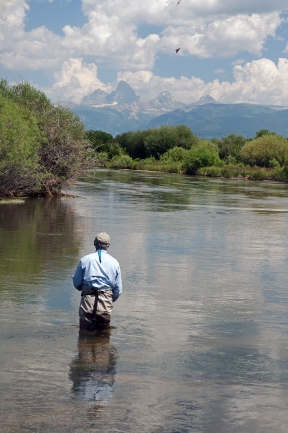
For most folks other than those living in the Upper Henry’s Fork Basin, June 5th is just another day. For those of us who have lived here more than forty years this date brings back memories of the most catastrophic event ever to hit this valley. On June 5, 1976 just before noon an earthen dam on the Teton River collapsed resulting in the deaths of 11 people, 13,000 cattle and other livestock, and completely flooded the towns of Sugar City, Rexburg and all of the outlying rural areas. The total damage estimates have ranged up to $2 billion.
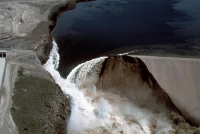
40 years ago on June 5th my brother Rick and I were fishing on the Firehole River in Yellowstone Park. We broke for lunch and when we got back to my truck we heard the news on the radio. While the devastation missed St. Anthony it totally inundated Sugar City, where I had spent most of my life. Our family had moved away but all of the friends and neighbors I had grown up with lost everything. My grandfather, who lived 35 miles west in Roberts, also lost his home and most of his other earthly possessions.
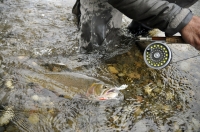
Another event in 1976 was the organization of our business. The ramifications of the devastating flood really hit home when we started construction of our fly shop in Island Park. Virtually all of the building contractors, electricians and plumbers were up to their eyeballs trying to reconstruct Madison and Southern Fremont Counties. Lumber, concrete, and other building supplies were in such high demand it was impossible to get anything in Island Park. We had to get our concrete for the footings and foundation from Bozeman 125 miles away. It was only through the efforts of Sheralee’s father, Frank Rydalch, his hired man, and two contractors, Ron Dye and Gary Skoy, that construction of our log building was possible. Luckily Ron and Gary, who lived in Last Chance, preferred to work in the mountains.
A couple of years later Glenn Foster, an outfitter who had a Teton River outfitting permit, offered to sell us the Teton portion of his business for $6000.00, which also included 2 whitewater rafts. The rafts alone were worth $6000.00. I passed not only because I didn’t have the money but also because I didn’t think I’d ever see the Lower Teton River fish again during my lifetime. The flood moved millions of tons of sediment downstream where it also filled in the Lower Henry’s Fork. It was a major emotional tragedy for me to see the river that flowed within bike riding distance from my home totally destroyed.
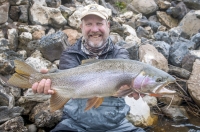
Today there is little evidence of what happened. Many of the larger buildings in Sugar City and Rexburg still stand but most of the original homes are gone. The scenes from the wipe out of the two cities are now only fading memories. Today there aren’t many homes that are more than 40 years old.
Even more amazing is the Lower Teton River. Within a few years it started to heal. Over time the heavy spring runoff from the Teton Range cut through the silt and sediment until the water reunited with its original channels. The Teton is one of the only rivers that forks away from itself. The channels part company southeast of St. Anthony and join the Henry’s Fork about 5 miles apart.
While the Lower Teton isn’t the same river it was before the flood, it has once again become a viable trout stream capable of producing some giant trout. Today a 5lb trout from this water isn’t likely to raise any eyebrows. As I look back over 40 years as a fly fishing outfitter, there have been a lot of successes as well as some disappointments. For many years I looked back at the missed opportunity to guide our clients on the Teton River with angst. This changed late in 2014 when another opportunity presented itself. 2015 was the first complete season to utilize the Teton River. The largest trout caught by one of our clients was a 28” Rainbow on a dry fly.
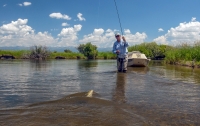
The Teton River has a lot of similarities with the Henrys Fork. The upper river meanders through the Teton Basin, known by the mountain men as Pierre’s Hole, in true spring creek fashion. The view from the shadows of the Teton Peaks is spectacular. This part of the river is loaded with Brook Trout, rainbows as well as some hefty Native Cutthroats.
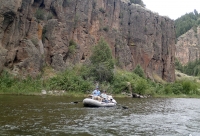
The middle section falls through a deep canyon where it cascades over rocks and boulders. Access is difficult requiring a steep 1500 foot climb over unimproved trails where you must stay alert for rattlesnakes. While part of the canyon is not navigable there are a couple of sections which provide whitewater excitement and spectacular fishing. Getting there requires dragging our rafts over a steep access trail.
You can access the dam site by a gravel road from State Highway 33. It’s worth a look even if you don’t fish. From a fishing standpoint, the old dam offers an unimproved boat access for floating. The float from the dam down provides about 5 miles of prime water. You can get a very interesting perspective as you float through the bowels of the old dam.
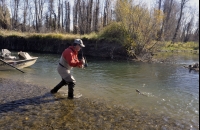
The Lower Teton is simply amazing. Some of this section is like an oversized irrigation canal but it still produces some great fishing. The overall numbers of trout are not high but the quality of the fish more than make up for it. As you get closer to the Henry’s Fork the river flows through the sediment that was deposited from the flood in 1976. It always gives me an eerie feeling to see a pre-1976 vintage car or tractor body sticking out of a 15 foot bank.
If you find yourself driving through Rexburg whether going to or from your fishing area or just cruising, stop by and check out the Museum of Rexburg, originally known as the Teton Flood Museum. The Teton Flood Exhibit is definitely worth a look. Like the Madison River Slide area at Quake Lake that was formed by a massive earthquake in 1959, these historical sites provide a measure of the power of nature but also the power to heal. Both the Teton and Madison Rivers are prime fisheries today.